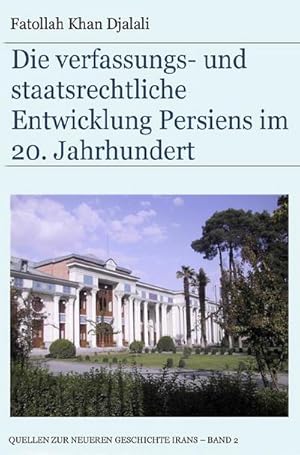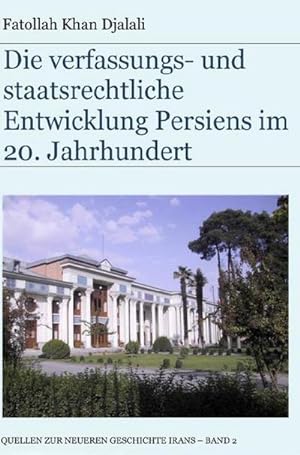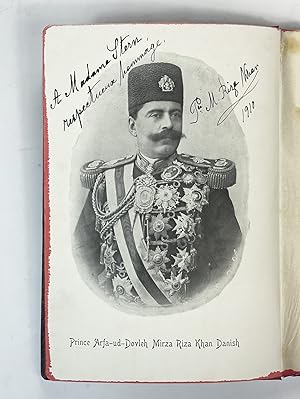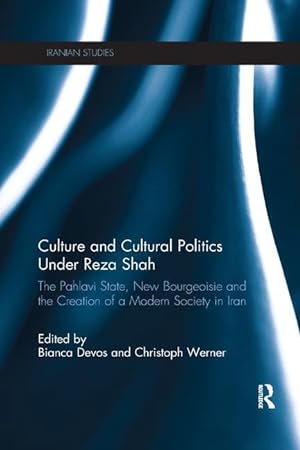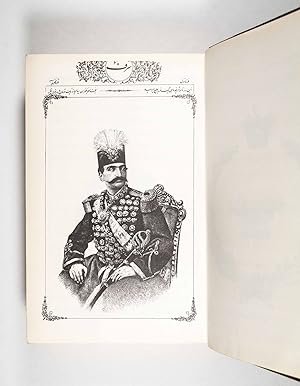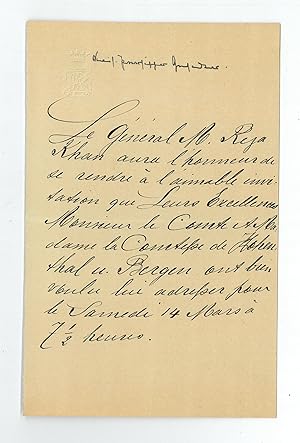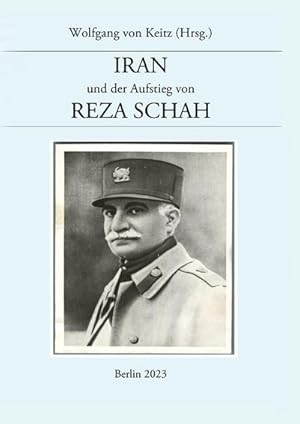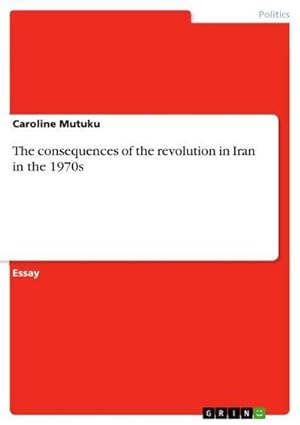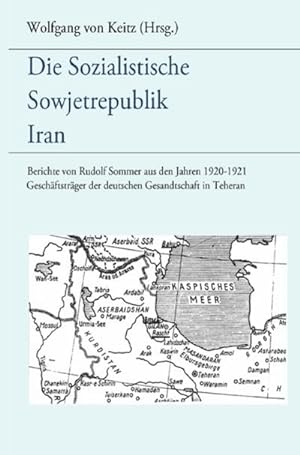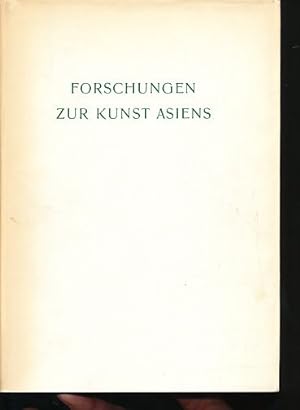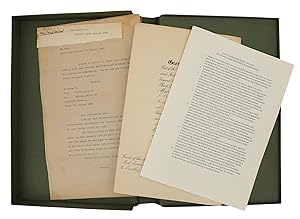reza khan (32 Ergebnisse)
Produktart
- Alle Produktarten
- Bücher (30)
- Magazine & Zeitschriften
- Comics
- Noten
- Kunst, Grafik & Poster (1)
- Fotografien
- Karten
-
Manuskripte &
Papierantiquitäten (1)
Zustand
Einband
Weitere Eigenschaften
Land des Verkäufers
Verkäuferbewertung
-
PAPERBACK. Zustand: Good. Paperback edition. 92pp. octavo paperbound. tight binding. wrap worn: creasing, faded, warped, some rubbing. creased on spine. previous owner's name inked on title page. interior clean throughout.
-
Minister des Nawab Wesir von Oudh (Provinz Agra and Oudh, India). Um 1780. Brustbild mit Pelzkappe im Oval. Feiner Punktierkupferstich von Joseph Singleton. 200 x 152 mm. sehr schönes Exemplar mit Rand.
-
Ethics and Integrity in Teacher Education
Verlag: Springer International Publishing, 2024
ISBN 10: 3031169247ISBN 13: 9783031169243
Anbieter: AHA-BUCH GmbH, Einbeck, Deutschland
Buch
Taschenbuch. Zustand: Neu. Druck auf Anfrage Neuware - Printed after ordering - This book addresses issues related to ethics and integrity in teacher training. Authors pay special attention to the role ethics plays in teaching practice and the importance of establishing expectations for students to learn with integrity from a young age. The book celebrates global perspectives on ethics and integrity for pre-service teachers, acknowledging that although some aspects of ethics are universal, the ways in which these are implemented can vary. Contributors present original research, case studies, and recommendations for practice and teaching.The book draws on a range of theoretical and conceptual foundations including applied ethics, academic integrity, and moral education.
-
Ethics and Integrity in Teacher Education
Verlag: Springer International Publishing, 2023
ISBN 10: 3031169212ISBN 13: 9783031169212
Anbieter: AHA-BUCH GmbH, Einbeck, Deutschland
Buch
Buch. Zustand: Neu. Druck auf Anfrage Neuware - Printed after ordering - This book addresses issues related to ethics and integrity in teacher training. Authors pay special attention to the role ethics plays in teaching practice and the importance of establishing expectations for students to learn with integrity from a young age. The book celebrates global perspectives on ethics and integrity for pre-service teachers, acknowledging that although some aspects of ethics are universal, the ways in which these are implemented can vary. Contributors present original research, case studies, and recommendations for practice and teaching.The book draws on a range of theoretical and conceptual foundations including applied ethics, academic integrity, and moral education.
-
Two books by Mirza Reza Khan, Persian diplomat and poet, with related material
Verlag: c.1920]., 1920
Anbieter: Maggs Bros. Ltd ABA, ILAB, PBFA, BA, London, Vereinigtes Königreich
Erstausgabe
[1] ARFA? (Riza), i.e. [KHAN (Mirza Reza)]. Muntakhab-i Danish. (Selected Knowledge). First edition. Varying lines of Persian naskh within double-ruled frames. Full-page black and white half-tone portrait of the author. 8vo. Original teal cloth, gilt, covers elaborately blind-stamped; spine a touch sunned, several tiny white stains to covers, otherwise very good. 96, 26pp. Istanbul, Matba?ahi-i Akhtar, 1309 AH [1892/93 AD]. [2] ARFA? (Riza), i.e. [KHAN, (Mirza Reza)]. Divan Gohar Khavari. (Divan Eastern Gem). Presumed first edition. Lithographed Persian text, with varying lines of nasta'liq in chromolithographed gold floral borders, chromolithographed title-page printed in gold, iridescent red and iridescent green. With 72 full-page black and white photo-engravings (including 52 reproductions of ms. leaves, letters and certificates) and 9 full-page colour illustrations (a line-drawing repeated in different colours). 4to. Original orange-red morocco, richly gilt, green morocco central medallions to both covers, corner-pieces of green morocco inlay to upper cover, bevelled boards, speckled edges, lime green silk tie loosely inserted; extremities a little rubbed, a few light grazes to covers, otherwise very good. [1], 208, [5]pp. N.p., n.d., but [c.1905 AD]. [3] UNIDENTIFIED ARTIST. Needlework sampler of Mirza Reza Khan?s Coat of Arms. Sampler in white, green, red and gold thread on emerald fabric, measuring 270 by 320mm. Backed with linen, metal hoops at top corners, a little crumpled in places, a few threads coming loose, otherwise in excellent condition. N.p. [but likely Monaco], 1320 AH [1907/08 AD]. [4] UNIDENTIFIED PHOTOGRAPHER. Photograph of Mirza Reza Khan with a qalyan, and two photographs of his daughter Fatima in dance costumes. Three original silver-gelatin photographs, measuring 134 by 85mm, and 144 by 89mm. All in very good unfaded condition, one printed as a postcard with ms. message by Fatima in Swedish. N.p., n.d. but [Monaco, A small but attractive gathering of items relating to the life of Mirza Reza Khan Arfa? (1846-1939), a Persian diplomat who fulfilled a diverse array of roles during the late Qajar period. They exemplify the striking visual legacy he left behind in books, artworks and architecture, often mixing Western and Persianate features. Reza was born in Tabriz and looked set for training at a religious school when a downturn in his family?s fortunes redirected his path to Istanbul, where his brother-in-law ran a shop. Outside of working hours he studied the manifold languages of the city, soaking up French and Turkish. It was in Tbilisi, on his return journey to Iran, that he took up a humble role at the Persian consulate and began to learn Russian. He was then in the right place at the right time when ?the court of Naser al-Din Shah ? needed a Russian interpreter for his journey across the Caucasus on the way to Europe? (Sirjani, Encyclopaedia Iranica), thus kick-starting his diplomatic career. Having given a good account of himself, he was made third secretary at the Tiflis consulate and later won roles on the frontier commission of Khorasan-Ahal and the suite of the Shah for his final trip to Europe (cf. Diba, Tabriz in Monaco). After becoming consul-general in Tiflis, increasingly important roles followed, such as Minister to the Russian Court at St Petersburg (1312/1895), representative of Persia at the first Hague Conference (1899) and Ambassador to the Ottoman court (1317/1900). Alongside his professional commitments he showed a strong appetite for the arts, not only as a collector but as the author of over a dozen books. Though his output is not of great literary significance ? EI describes his poetry as ?mediocre? (ibid.) ? it stands as a fascinating example of cross-cultural book production at the turn of the century, with works in Farsi, French, Russian and Swedish, published across several cities, including Tehran, Istanbul, St. Petersburg, Paris and Stockholm. The two books here, Muntakhab-i Danish and Divan Gohar Khavari, are examples of his Persian-language poetry, the former printed with moveable type and the latter predominantly with lithography. Divan Gohar Khavari, in particular, fully embodies his maximalist sensibility and desire to employ aspects of Persian book production. A work of biography in verse, it features typographic page numbers, lithographed text (in nasta?liq script) and chromo-lithographed borders and titles in gold and iridescent inks. All of which is printed on paper so smooth (presumably in imitation of polished paper), that the ink appears to have struggled to set. The illustrations, most of which are photo-engravings, show the author and various scenes from his career, including images of the Russian Court, Nicholas II and the empress consort, Alexandra Feodorovna. The largest and most conspicuous of Reza?s creations were his houses, in Tabriz, Borjomi and Monaco, which took inspiration from the great masterpieces of Safavid architecture. Each contained large collections of Iranian art and items created by Reza?s family. The needlework sampler and small photographs give a sense of those interiors and though unsigned (apart from one photo-postcard) appear to have been made by his daughter Fatima at their Monaco residence (Villa Daneshgah), where the family lived for much of the time after 1910. The sampler copies Reza?s coat of arms, a beautiful design made in 1320 AH (1902/03 AD), with sewn titles and mottos in French and Farsi. One of the Farsi titles announces him as the ?Prince of Peace?, and the French motto ?Paix porte prospérité? also points to the peacekeeping component of his diplomatic career; not to mention a nod to the wealth that came his way, some of which was gained ?reportedly not always through honest means? (ibid.). The photographs were probably taken at a studio in Monaco, or in Villa Daneshgah. Of small size, they were likely intended as gifts and keepsakes, with one used as a postcard by Fatima (writt.
-
The Transition in Bengal, 1756â "75: A Study of Saiyid Muhammad Reza Khan (Cambridge South Asian Studies, Series Number 7)
Verlag: Cambridge At The University Press, 1969
Anbieter: World of Rare Books, Goring-by-Sea, SXW, Vereinigtes Königreich
Zustand: Good. 1969. No Edition Remarks. 376 pages. Pictorial dust jacket over blue cloth. Black and white illustrated frontispiece. Binding remains firm. Pages are lightly tanned throughout. Boards have light shelf-wear with corner bumping. Slight crushing to spine ends. Clipped jacket has light edgewear with tears and creasing. Sticker to front flap. Light tanning to spine and edges. Light wear marks overall.
-
Transition in Bengal, 1756-1775 : A Study of Saiyid Muhammed Reza Khan
Verlag: Cambridge University Press, 1969
ISBN 10: 0521071240ISBN 13: 9780521071246
Anbieter: Better World Books, Mishawaka, IN, USA
Buch
Zustand: Very Good. Former library book; may include library markings. Used book that is in excellent condition. May show signs of wear or have minor defects.
-
Relation de l\ Ambassade Au Kharezm de Riza Qouly Khan (Ed.1876-1879)
Verlag: HACHETTE LIVRE, 2012
ISBN 10: 2012767346ISBN 13: 9782012767348
Anbieter: moluna, Greven, Deutschland
Buch
Zustand: New.
-
The Transition in Bengal, 1756 75 : A Study of Saiyid Muhammad Reza Khan
Verlag: Cambridge University Press, 2007
ISBN 10: 0521049822ISBN 13: 9780521049825
Anbieter: AHA-BUCH GmbH, Einbeck, Deutschland
Buch
Taschenbuch. Zustand: Neu. Druck auf Anfrage Neuware - Printed after ordering - This study includes the early life of Saiyid Muhammad Reza Khan but concentrates particularly upon the years from 1756 to 1775.
-
The Gardens of Consolation
Verlag: Europa Editions Jan 2017, 2017
ISBN 10: 1609453506ISBN 13: 9781609453503
Anbieter: Smartbuy, Einbeck, Deutschland
Buch
Taschenbuch. Zustand: Neu. Neuware - A novel of love, family, and a fight for freedom in Iran featuring a 'formidable and hard-to-forget heroine' (Publishers Weekly).In the early 1920s, in the remote Persian village of Ghamsar, two young people dreaming of a better life fall in love and marry. Sardar brings his bride, Talla, with him across the mountains to the suburbs of Tehran, where the couple settles down and builds a home. From the outskirts of the capital city, they will watch as the Qajar dynasty falls and Reza Khan rises to power as Reza Shah Pahlavi.Into this family of illiterate shepherds is born Bahram, a boy whose brilliance and intellectual promise are apparent from a very young age. As he grows older, Bahram will become a fervent follower of reformer Mohammad Mosaddegh and will participate firsthand in his country's political and social upheavals, putting himself in mortal danger, in this prize-winning, 'compelling book [that] raises important questions about indulgence, gender, community, and the impact of politics on everyday life' (Kirkus Reviews).'Exquisite . . . the narrative evolves from an intimate chronicle of Talla and Sardar's provincial lives into a sweeping tour through early-20th-century Iran.'-The New York Times 272 pp. Deutsch.
-
Liaquat Ali Khan: His Life and Times
Verlag: Oxford University Press, USA, 2003
ISBN 10: 0195797884ISBN 13: 9780195797886
Anbieter: ThriftBooksVintage, Tukwila, WA, USA
Buch
Hardcover. Zustand: Good. No Jacket. Shelf and handling wear to cover and binding, with general signs of previous use. Wear commensurate with age and use. Gift inscription in ink on front endpaper, otherwise clean and unmarked copy. Bumping visible to corners of boards and ends of spine strip. Dust jacket wrapped in protective mylar sleeve. Secure packaging for safe delivery. 1.45.
-
[SECRET TREATIES / ANGLO-PERSIAN AGREEMENT OF 1919] Manzûme-yi Sulh ve re'y-i Dânîsh [ve tercümesi]. [i.e. Peace agreement and views of Mirzâ Dânîsh]. Translated into Ottoman Turkish by Ferid [Kam].
Verlag: Matbaa-i Zelliç [i.e. Zellitch Brothers Printing House]., [ca. 1920], Istanbul, 1920
Anbieter: Khalkedon Rare Books, IOBA, Istanbul, Türkei
Buch Erstausgabe
Soft cover. Zustand: Very Good. 1st Edition. First Edition of this extremely rare bilingual tractate including Prince Reza Khan's thoughts on Anglo-Persian agreement in1919. Mirza Reza Khan also known as Prince Rezâ Arfa', was a diplomat and poet of the late Qajar period who serviced in Constantinople. During his years of service abroad Reza became acquainted with a number of European political leaders. He was reported to entertain Russian sympathies and was certainly instrumental in negotiating the first Russian government loan to Persia, in 1317 / 1900. Nevertheless, he also appears to have supported the Anglo-Persian Agreement of 1919. In 1332 / 1914 he served as minister of justice (wazîr-e 'adlîya) in Tehran for about a year. This agreement in 1919 was a provisional agreement made between the British and the Persian governments which, if ratified, would have granted the British a paramount position of control over the financial and military affairs of Iran. From the days when Napoleon conceived the idea of invading India with the help of Alexander I, the Tsar of Russia, Great Britain contemplated with apprehension the invasion of India by Russia via Persia and Afghanistan. Under the Anglo-Russian Convention of 1907 (q.v.), which divided Persia into rival spheres of influence, southern Persia was assigned to Britain while Russia controlled the northern portion. Later, according to the terms of "The Secret Treaties of Constantinople" of 18 March 1915, Constantinople was promised to Russia, and England was allowed to incorporate within her sphere of influence the neutral zone of Persia. (Source: Encyclopedia Iranica). Original wrappers. Slightly chipped on extremities and occasionally foxing on cover. Otherwise a very good copy. Roy. 8vo. (23 x 16 cm). Bilingual in Persian and Ottoman script. [34] p., 7-18 pp. text in Persian, 19-34 pp. translation to Ottoman Turkish, a portrait of Prince Mirza Riza Han with a printed signature and inscription, and facsimile litho page of his manuscript poem in his calligraphy. Turkish chapter is in naskh, Persian chapter is in taliq script. Lithography. Not in OCLC.; Özege 25155.; TBTK 8061. First Edition. Extremely rare.
-
Relation de l\ Ambassade Au Kharezm de Riza Qouly Khan
Verlag: HACHETTE LIVRE, 2017
ISBN 10: 2019156458ISBN 13: 9782019156459
Anbieter: moluna, Greven, Deutschland
Buch
Zustand: New.
-
Quellen zur neueren Geschichte Irans / Die verfassungs- und staatsrechtliche Entwicklung Persiens im 20. Jahrhundert
Verlag: Epubli, 2017
ISBN 10: 3745006674ISBN 13: 9783745006674
Anbieter: AHA-BUCH GmbH, Einbeck, Deutschland
Buch
Taschenbuch. Zustand: Neu. Druck auf Anfrage Neuware - Printed after ordering - Die Bilder aus dem Iran sind heute geprägt von Frauen im Tschador und Geistlichen, die Regierungsämter ausüben. Ein religiöser 'Führer' bestimmt die politischen Geschicke des Landes. Ihm unterstehen die Streitkräfte, die Polizei und die Revolutionsgarden, das Justizsystem und die Kontrolle der Medien. Der 'Führer' kontrolliert die Regierung und über den Wächterrat, einem aus 12 Personen bestehenden Gremium aus Geistlichen und Rechtsgelehrten, den Gesetzgebungsprozess. Ruholla Chomeini, der im Rahmen der 'Islamischen Revolution' die seit 1906 bestehende Verfassung aufgehoben und durch eine 'Islamische Verfassung' ersetzt hat, hatte seine Absichten in seinem Exil im französischen Neauphle-le-Château eindeutig klargestellt: 'Es darf nicht noch einmal passieren, was in der Konstitutionellen Revolution passiert ist, dass wir Geistliche uns an einer Revolution beteiligen, und am Ende die säkularen Kräfte siegen.'Welche Verfassung im Iran von 1906 bis 1979 gültig war, wie diese Verfassung strukturiert war, und welche revolutionären Umwälzungen mit der Einführung dieser Verfassung verbunden waren, ist im deutschen Sprachraum weitgehend in Vergessenheit geraten. Dabei ist die Verfassungsgeschichte Irans an Dramatik kaum zu überbieten.Fatollah Djalali schildert die Ereignisse der Konstitutionellen Revolution und berichtet über die weitere Entwicklung des persischen Staatswesens bis zur Krönung Reza Schah Pahlavis im Jahre 1926. Er berichtet von den politischen und militärischen Interventionen der Kolonialmächte England und Russland, den Auswirkungen des Ersten Weltkrieges auf die noch junge konstitutionelle Monarchie, der Einfluss der russischen Oktoberrevolution auf die weitere politische Entwicklung des Irans und dem Scheitern des Versuches Englands aus Iran ein britisches Protektorat zu machen.Das Buch von Fatollah Khan Djalali ist ein einmaliges Zeitdokument. Djalali schildert als Betroffener und Zeitzeuge die revolutionären Ereignisse in deutscher Sprache.
-
Die verfassungs- und staatsrechtliche Entwicklung Persiens im 20. Jahrhundert
Verlag: Epubli, 2021
ISBN 10: 3754106589ISBN 13: 9783754106587
Anbieter: AHA-BUCH GmbH, Einbeck, Deutschland
Buch
Taschenbuch. Zustand: Neu. Druck auf Anfrage Neuware - Printed after ordering - Die Bilder aus dem Iran sind heute geprägt von Frauen im Tschador und Geistlichen, die Regierungsämter ausüben. Ein religiöser 'Führer' bestimmt die politischen Geschicke des Landes. Ihm unterstehen die Streitkräfte, die Polizei und die Revolutionsgarden, das Justizsystem und die Kontrolle der Medien. Der 'Führer' kontrolliert die Regierung und über den Wächterrat, einem aus 12 Personen bestehenden Gremium aus Geistlichen und Rechtsgelehrten, den Gesetzgebungsprozess. Ruholla Chomeini, der im Rahmen der 'Islamischen Revolution' die seit 1906 bestehende Verfassung aufgehoben und durch eine 'Islamische Verfassung' ersetzt hat, hatte seine Absichten in seinem Exil im französischen Neauphle-le-Château eindeutig klargestellt: 'Es darf nicht noch einmal passieren, was in der Konstitutionellen Revolution passiert ist, dass wir Geistliche uns an einer Revolution beteiligen, und am Ende die säkularen Kräfte siegen.'Welche Verfassung im Iran von 1906 bis 1979 gültig war, wie diese Verfassung strukturiert war, und welche revolutionären Umwälzungen mit der Einführung dieser Verfassung verbunden waren, ist im deutschen Sprachraum weitgehend in Vergessenheit geraten. Dabei ist die Verfassungsgeschichte Irans an Dramatik kaum zu überbieten.Fatollah Djalali schildert die Ereignisse der Konstitutionellen Revolution und berichtet über die weitere Entwicklung des persischen Staatswesens bis zur Krönung Reza Schah Pahlavis im Jahre 1926. Er berichtet von den politischen und militärischen Interventionen der Kolonialmächte England und Russland, den Auswirkungen des Ersten Weltkrieges auf die noch junge konstitutionelle Monarchie, der Einfluss der russischen Oktoberrevolution auf die weitere politische Entwicklung des Irans und dem Scheitern des Versuches Englands aus Iran ein britisches Protektorat zu machen.Das Buch von Fatollah Khan Djalali ist ein einmaliges Zeitdokument. Djalali schildert als Betroffener und Zeitzeuge die revolutionären Ereignisse in deutscher Sprache.
-
Perles d'Orient / Signed Example for Ernesta Stern
Verlag: Istanbul: Levant Herald ., 1904
Anbieter: Antiquariat Dasa Pahor GbR, München, Deutschland
Buch
8°, [2 pp.], portrait of the author, printed on thicker paper, with a dedication by the author to Ernesta Stern, dated 1910, silk paper guard, 199 pp. with small vignettes and blue ornaments in margins, [3 pp.] blank, original dark redish-brown binding with gold lettering, original patterned endpaper, red edges, bookplate of Ernesta Stern mounted on the inner side of the front board (binding slightly age-toned with a tiny crack in the upper part of the spine verso, internally in a clean and crisp condition). A rare first edition of poems and short essays on the Orient was published in French language in Istanbul by a Persian diplomat and writer Mirza Reza Khan Arfa Al-Dawlah (1846 1937) and contains a hand-written dedication to an intellectual and bibliophile Ernesta Stern, a famous Jewish literary hostess and an author. - Ernesta Stern (née Maria Ernesta Hierschel de Minerbi, nom de plume Maria Star, 1854 1926) born to a Jewish family in Trieste, Austro-Hungary, became one of the central figures of a Parisian literary gatherings of the late 19th and early 20th centuries. In 1874, Ernesta married Louis Stern (1840-1900) from a wealthy and prominent Jewish family of bankers, originating from Frankfurt, after which she moved to Paris, where she started hosting a literary salon in their city palace on 68 rue du Faubourg-Saint-Honoré. Stern s salons became one of the most prominent intellectual events in Paris, bringing together people, such as Filippo Tommaso Marinetti and Marcel Proust. Ernesta Stern owed a large private library of works, written by the people visiting her salon and dedicated to her. The books were either bound in elegant Morocco bindings with Stern s monogram or contained her bookplate. She authored about 20 works herself. In 1904, Ernesta had commissioned a prominent villa named Villa Torre Clementina, located in Roquebrune-Cap-Martin, on the French Riviera, east from Monaco. The villa became a new gathering place for literati and is today protected as a historical monument. In 1920, Ernesta Stern was awarded the knighthood of the Legion of Honour. Mirza Reza begun his diplomatic career in Tiflis in 1873 as an interpreter to Russian to the Persian Shah Naser al-Din Shah Qajar. In 1889, he was appointed Persian consul-general in the same city. In 1895, Mirza Reza was named Persian minister to the Russian court at St. Petersburg and five years later, he was transferred to Istanbul as an ambassador to the Ottoman court. His wife Elsa Cecilia Maria Lindberg-Dovlette (1874-1944) was a known Swedish writer, who published three reports on the Ottoman harems as an insider: Kvinnor fran minareternas stad (1908, Women from the City of Minarets), Främling (1924 and 1929, Stranger) and Bakom stängda haremsdörrar (1931, Behind the Closed Doors of the Harem). This is a rare first edition, published by Levant Herald in Istanbul, where Mirza Reza Khan worked as a Persian ambassador at the time. The second, more common one, was published a year later in Paris. We could only trace one institutional example of Worldcat (Bibliothèque nationale de France). References: OCLC 458009680, 417479787 (with no listed examples in libraries).
-
Culture and Cultural Politics Under Reza Shah
Verlag: Taylor & Francis, 2017
ISBN 10: 0815361181ISBN 13: 9780815361183
Anbieter: moluna, Greven, Deutschland
Buch
Kartoniert / Broschiert. Zustand: New.
-
Sharaf and Sherafat . In One Volume (Persian Journal)
Verlag: Islamic Revolution Publications and Educational Organization, Tehran, 1976
Anbieter: ERIC CHAIM KLINE, BOOKSELLER (ABAA ILAB), Santa Monica, CA, USA
Hardcover. Zustand: Very good condition. Facsimile edition. Folio (15 1/2 x 10"). Original brown paper-covered boards with gilt decor on covers, gilt illustrated spine with gilt lettering on red leather label. Decorative endpapers. Publisher's device covered with label of "Islamic Revolution Publications." Printed and bound by the Offset Press, Inc., Tehran. A monthly paper published under the management of Mohammad Hasan Khan Etemad-Saltaneh, Minister of Press and Translation Department. Sharaf Nos. 1-87, 1882-1891, with portraits by Abu Torab Ghaffari and Mirza Musa, calligraphy by Mohammad Reza Kalhor, and Sherafat Nos. 1-66, 1896-1903, with portraits by Mehdi Mosavverolmolk. Mohammad Hasan Khan graduated as a historian and geographer from Dar al-Funun University of Technology, the first modern university and institution of higher learning in Iran. To depict the famous Iranian and foreign notables, politicians and artists of the time for the magazine he hired famous calligraphers, painters and photographers to complete the biographies and portraits published in the magazine. Contains some 150 facsimile portraits of Qajar, Chinese, Egyptian, and European Nobility and Royalty and illustrations of historical palaces and important monuments. The realistic style of painting presented in the magazines revolutionized the art and painting during the time when photography was on the rise in Iran. Text in Farsi with English title page. Binding with some light wear along edges and joints with very light fraying at head and tail of spine. Publisher's device on plastic label in brown glued to endpapers.
-
2 autograph letters signed.
Verlag: No place or date.
Anbieter: Antiquariat INLIBRIS Gilhofer Nfg. GmbH, Vienna, A, Österreich
Manuskript / Papierantiquität
8vo. 2 pp. on 3 ff. Accepting an evening invitation extended by the writer Fedor von Zobeltitz and his wife: "Le Général M. Reza Khan aura l'honneur de se rendre à la gracieuse invitation que M. et Madame de Zobeltitz Spiegelberg ont bien voulu lui adresser [.]". - Accepting an invitation from the count and countess of Hohenthal und Bergen: "Le Général M. Reza Khan aura l'honneur de se rendre à l'aimable invitation que Leurs Excellences Monsieur le Comte et Madame la Comtesse de Hohenthal u. Bergen ont bien voulu lui adresser [.]". - Both letters with embossed monogram. Includes an old collection envelope.
-
A State of the British Authority in Bengal under the Government of Mr. Hastings. Exemplified in his Conduct in the Case of Mahomed Reza Khan. With a Debate upon a Letter from Mobareck Ul Dowlah, Nabob of Bengal. From authentic Documents.
Verlag: London: Printed by H. S. Woodfall: Sold by J. Dodsley and R. Baldwin, 1780
Anbieter: Forest Books, ABA-ILAB, Grantham, LINCS, Vereinigtes Königreich
Erstausgabe
First Edition, no half-title, advertisement leaf following the title with a glossary of Moorish terms on verso, [4], 52 pp., disbound. Reza Khan had been charged with embezzlement, mal-administration, etc., and though he was acquitted he was not restored to office.
-
Iran und der Aufstieg von Reza Schah : Telegramme und Berichte des Geschäftsträgers der Deutschen Gesandtschaft 1920 - 1925
Verlag: Epubli
ISBN 10: 375841007XISBN 13: 9783758410079
Anbieter: AHA-BUCH GmbH, Einbeck, Deutschland
Buch
Taschenbuch. Zustand: Neu. Druck auf Anfrage Neuware - Printed after ordering - Iran ist wieder in den Fokus der Weltpolitik gerückt. Die Bevölkerung im Iran begehrt gegen ein islamistisches Regime auf, das nach dem Sturz der konstitutionellen Monarchie eine Islamische Republik errichtet hat. Auf den Straßen Irans hört man Rufe nach 'Reza Schah, Reza Schah'. Die Iraner und vor allem die Iranerinnen sehen ihre Zukunft in der Rückkehr zu einem Staatswesen mit einem frei gewählten Parlament und einem Schah an der Spitze als Staatsoberhaupt, der als Garant für Stabilität und Wohlstand gilt. Wer war Reza Schah, und warum werden heute im Iran Rufe nach einem Mann laut, der vor beinahe hundert Jahren durch eine Verfassungsänderung Schah wurde Als Reza Khan mit einem Staatsstreich im Februar 1921 die politische Bühne betrat, war die staatliche Einheit Irans gefährdet. Iran drohte zu einer bolschewistischen Republik zu werden. Im Norden Irans war eine Sozialistische Sowjetrepublik ausgerufen worden. Und auch hier muss man sich wieder fragen, wie es möglich war, dass im Norden Irans eine bolschewistische Bewegung entstehen konnte Wo-ran ist die Übernahme der Macht der Bolschewiken in ganz Iran gescheitert Und welche Rolle spielte Reza Kahn, ein bis dato vollkommen unbekannter Offizier der persischen Kosaken, bei der Niederschlagung dieser bolschewistischen Bewegung Dass wir heute sehr detaillierte Informationen über die damaligen politischen Vorgänge im Iran haben, haben wir einem Glücksfall zu verdanken. Die deutsche Gesandtschaft war im Laufe des Ersten Weltkrieges auf Drängen von England und Russland geschlossen worden. Nur Rudolf Sommer, der Geschäftsträger der Deutschen Gesandtschaft, blieb in Teheran und schrieb detaillierte Berichte, telegrafierte nach Berlin, was er eilig übermitteln wollte. Er übersetzte Artikel aus den Tageszeitungen, um Hintergrundinformationen über die politischen Geschehnisse an das Auswärtige Amt zu senden.
-
Im Auto durch Persien : Reisen einer adligen Rebellin durch ein Land im Aufbruch. DE
Verlag: Epubli, 2022
ISBN 10: 3754968556ISBN 13: 9783754968550
Anbieter: Smartbuy, Einbeck, Deutschland
Buch
Taschenbuch. Zustand: Neu. Druck auf Anfrage Neuware - Printed after ordering - Unter dem Titel 'Im Auto durch Persien' veröffentlicht Annemarie von Nathusius einen Reisebericht von einer 1924 unternommen Reise von Bremen mit dem Schiff bis Buschehr und dann weiter mit einem Mercedes über Land bis nach Teheran. In Persien trifft sie mit Männern der persischen Oberschicht zusammen und erhält sogar eine Einladung zu einem Treffen mit Premierminister Reza Khan, des späteren Reza Schah Pahlavi. Reza Khan muss Gefallen an Annemarie von Nathusius gefunden haben, denn er lud sie zu einem Polospiel und dann später in sein Haus ein. Annemarie von Nathusius hat viele Gespräche geführt. Unter anderem mit einer Gruppe persischer Frauen, einem Frauenclub, die sich gegen die Verschleierung, den Tschador und gegen die von der Familie arrangierte Ehe aussprach. Sie, die sie selbst gegen die Moral- und Ehevorstellungen ihrer Zeit angeschrieben hat, berichtet ausführlich von dieser Begegnung. Sie ermuntert die Frauen, Widerstand zu leisten und sich mit den persischen Männern zusammenzuschließen, die in Europa das Leben freier Frauen kennengelernt haben und sich als Ehepartnerin eine selbstständige, unverschleierte Frau wünschen. Am Ende wird dieser Reisebricht zu einer Anklageschrift gegen die Unterdrückung der Frauen in Persien. Annemarie von Nathusius ruft den persischen Frauen zu: 'Ihr Frauen Persiens, ihr Trauernden, ich trage euer Schicksal und eure Wünsche mit mir in die Welt hinaus. Auf dem Morgenrot meiner Hoffnung für euch sandte die Scheidende euch letzte Grüße. Eure Schleier werden sinken, ihr werdet berauscht die Freiheit wie einen köstlichen Reif um eure Stirnen binden. Denn sie ist das höchste Gut auf Erden! Sie ist der Preis des Leidens, die Krone der Kraft, eure Schleier werden sinken, ihr Trauernden, die roten Blüten der Freiheit werdet ihr an euren Gürtel stecken. Eure verwaisten Hände werden diese Blüten des Glücks voll Jubel halten, Blumen des Kampfes, Blumen des Sieges. Auf dem Morgenrot meiner Hoffnungen werfe ich euch diese Blumen zu.' 276 pp. Deutsch.
-
Bombay, Bagdad, Teheran : Meine Reise nach Persien
Verlag: Edition Erdmann Sep 2016, 2016
ISBN 10: 3737400326ISBN 13: 9783737400329
Anbieter: AHA-BUCH GmbH, Einbeck, Deutschland
Buch
Buch. Zustand: Neu. Neuware - Im Frühjahr 1926 reiste Vita Sackville-West auf einem langen Umweg - über Ägypten, Indien und den Irak, wo sie in Bagdad einige Tage im Haus der von ihr verehrten Orientreisenden und Arabistin Gertrude Bell verbrachte - nach Persien, um ihren Mann zu besuchen, der als Sekretär der englischen Gesadtschaft in Teheran tätig war. Sie liebt das Abenteuer. Selbst als ihr Autokonvoi auf dem Weg nach Teheran in Kurdistan von berittenen Banditen verfolgt wurde, ließ sie sich nicht aus der Ruhe bringen. In Teheran genoss sie den Luxus und fand Gefallen an 'Rebhühnern, Melonen, Granatapfelmarmelade und Schiras-Wein'. Dabei hielt sie mit Kritik am Pomp des Diplomatenlebens nicht zurück und ließ sich von den Schätzen des persischen Hofes und der Krönung von Schah Reza Khan Pahlewi nicht blenden: 'Amateurtheater'.
Mehr Angebote von anderen Verkäufern bei ZVAB
Neu ab EUR 18,00
-
The consequences of the revolution in Iran in the 1970s
Verlag: GRIN Verlag
ISBN 10: 3668745366ISBN 13: 9783668745360
Anbieter: Smartbuy, Einbeck, Deutschland
Buch
Taschenbuch. Zustand: Neu. Druck auf Anfrage Neuware - Printed after ordering - Essay from the year 2018 in the subject Politics - Region: Far East, grade: 2, , language: English, abstract: This research will discuss different ways, in which the Islamic Government has turned the country's social and economic status into unprecedented cascade. The Iranian revolution of 1979 was believed to be a turning point of the country's struggle for freedom and economic prosperity. Historically, Iran had experienced a series of power transition, especially during the 19th Century. In the early 19th Century, there was a remarkable power shift, which was characterized by a substantial change of leadership styles and developmental strategies. One of the power transitions, which occurred, in the 19th Century was the siege of the Kajar dynasty by Reza Khan, in 1921. Reza Khan overthrew the Kajar dynasty because; he was dissatisfied with the developmental strategies adopted by the Iranian leader. Moreover, the Iranian political regime exercised unprecedented social injustices, especially under the Islamic law. Therefore, Reza overthrew the Kajar dynasty with the principal objective of igniting economic development and social transformation under the wave of western modernization and civilization. 16 pp. Englisch.
-
Königliche Romanzen Hefte 3, 4, 5, 6, 7, 9, 10, 11, 13, 14, 15 11 Hefte in einem Schuber
Verlag: Hamburg, Vlarshall Cavendish International Ltd., 1991
Anbieter: Andrea Ardelt, Großräschen, Deutschland
Buch
30 cm , kartoniert. ca. 530 Seiten , alle 11 Hefte befinden sich in einem Schuber und stammen aus einer Haushaltsauflösung, die Heftchen sind teils fleckig, der Schuber hat leichte Bestoßungen an den Kanten, HEFT 3: König Carl Gustaf und Königin Silvia - HEFT 4: König Juan Carlos und Königin Sofia - HEFT 5: Edward VIII. und Wallis Simpson - HEFT 6: George VI. und Elizabeth Bowes-Lyon - HEFT 7: Kronprinz Rudolf und Maria Vetsera - HEFT 9: Prinz Ali Khan und Rita Hayworth - HEFT 10: Prinzessin Beatrix und Claus v. Amsberg - HEFT 11: Prince Andrew und Sarah Ferguson - HEFT 13: Princess und Mark Philipps - HEFT 14: Schah Reza von Persien und Soraya - HEFT 15: Princess Margaret und Tony Armstrong-Jones 3n3b Sprache: Deutsch Gewicht in Gramm: 2500.
-
Die sozialistische Sowjetrepublik Iran : Berichte von Rudolf Sommer aus den Jahren 1920-1921. DE
Verlag: Epubli
ISBN 10: 3758495105ISBN 13: 9783758495106
Anbieter: Smartbuy, Einbeck, Deutschland
Buch
Taschenbuch. Zustand: Neu. Druck auf Anfrage Neuware - Printed after ordering - In den zwanziger Jahren des vorigen Jahrhunderts gab es im Norden Irans eine kommunistische Bewegung, die zum Ziel hatte, die Monarchie im Iran zu stürzen und in ganz Iran eine Sowjetrepublik zu etablieren. Dieser Versuch ist an dem erbitterten Widerstand der iranischen Regierung und der Schlagkraft der im Aufbau befindlichen neuen iranischen Armee unter der Führung ihres Oberbefehlshabers Reza Khan gescheitert. Niemand konnte zu diesem Zeitpunkt ahnen, dass der bis zu diesem Zeitpunkt völlig unbekannte Offizier Reza Khan nur wenig später Ministerpräsident und danach Schah werden sollte. Die Ereignisse der Jahre 1920 bis 1921 waren für die weitere politische Entwicklung Irans von besonderer Bedeutung. Der Geschäftsträger der Deutschen Gesandtschaft Rudolf Sommer hat für das Auswärtige Amt in Berlin ausführlich berichtet. Seine Berichte und Telegramme werden in diesem Buch widergegeben. 200 pp. Deutsch.
-
Digitalisierung im Marketing.
Verlag: Kohlhammer Verlag, 2021
ISBN 10: 3170374087ISBN 13: 9783170374089
Anbieter: SKULIMA Wiss. Versandbuchhandlung, Westhofen, Deutschland
Buch
Was Unternehmen heute für den Erfolg von morgen tun müssen. Hrsg. von Stefan Lacher, Philipp Tachkov und Rainer Völker. Das seit Jahren etablierte, klassische Marketing wird zugunsten neuer Ansätze verändert und modernisiert. In der Praxis entstehen damit neue Konzepte, die eine unmittelbare Kundenansprache ermöglichen und neue Chancen für die Bewerbung von Produkten und Dienstleistungen eröffnen. Der Band benennt und erläutert diese Entwicklungen, wobei einzelne Beiträge auch Best Practices darstellen, die von innovativen Unternehmen entwickelt bzw. angewendet werden und die eindrücklich die vielfältigen Möglichkeiten illustrieren. Mit Beiträgen von Peter Weber, Klaus Heinzelbecker, Gerd Nufer, Elmar Günther, Christian Deffte, Laurenz Wuttke, Lars Lamadé, Holger Schaaf, Nina Meinel, Edith Rüger-Muck, Heinrich Hanika, Michael Bernecker, Karl-Josef Mittler, Johanna Wolday, Daniela Huckele-Görisch, Theresa Ries, Viktoria Herrmann, Uwe Hannig, Laura Brommer, Philipp Piroth, Reza Mehman, Hans Joachim Fröhlich, Günter Dhom, Elisa Dorothee Adam, Lisa-Charlotte Wolter, Sylvia Chan-lmsted, Claus W. Gerberich, Meike Terstiege und Norbert Schuster. 292 Seiten mit 97 Abb., broschiert (Praxiswissen Management/Verlag W. Kohlhammer 2021) leichte Lagerspuren. Statt EUR 49,00 442 g. Sprache: de.
-
Forschungen zur Kunst Asiens. In Memoriam Kurt Erdmann, 9. September 1901 - 30. September 1964
Verlag: Istanbul Üniversitesi Edebiyat Fakültes Türk ve Islâm Sanati Kürsüsü, 1969
Anbieter: Fundus-Online GbR Borkert Schwarz Zerfaß, Berlin, Deutschland
Buch
Zustand: Gut. 323 S. Aus der Bibliothek von Prof. Dr. Wolfram Kleiss, langjährigem Leiter der Außenstelle Teheran des Deutschen Archäologischen Instituts. Einband leicht berieben. Umschlag leicht berieben, sonst gutes Exemplar. Mit Widmung von Rudolf Naumann. - O. GRABAR Sarvistan, a note on Sasanian Palaces -- R. GHIRSHMAN Disque en Bronze à Décor Ternaire -- RICHARD N. FRYE Inscribed Sasanian Seals from the Nayeri Collection -- ROBERT GÖBL Zum Chronologieproblem der Sasanidischen Kunst -- ELISABETH und RUDOLF NAUMANN Ein Kösk im Sommerpalast des Abaqa Chan auf dem Tacht-i Sulaiman und seine Dekoration -- FRANZ TAESCHNER Vom Heiligengrab zur Zunftzentrale -- ALESSIO BOMBACI Die Mauerinschriften von Konya -- JANINE SOURDEL-THOMINE Les Dates de Construction de l'Agzi Kara Han d'Après ses Inscriptions -- CHARLES K. WILKINSON Christian Remains from Nishapur -- RICHARD ETTINGHAUSEN A Case of Traditionalism in Iranian Art -- KATHARINA OTTO-DORN Die menschliche Figurendarstellung auf den Fliesen von Kobadabad -- OKTAY ASLANAPA Pottery and Kilns from the Iznik Excavations -- J M ROGERS Aeolipiles Again -- BASIL GRAY Some chinoiserie Drawings and their Origin -- G. M. MEREDITH-OWENS A Rare Illustrated Persian Manuscript -- WILHELM EILERS Illustration einer Gulistan-Geschichte durch Réza 'Abbasi -- M. S. DIMAND An Unpublished 17th Century Compartment Vase Carpet -- CHARLES GRANT ELLIS Caucasian Carpets in the Textile Muesum -- RUDOLF SCHNYDER Ziegler-Teppiche. Ein Beitrag zum Thema: Europa und der Orientteppich -- EMEL ESIN "AND" The Cup Rites in Inner-Asian and Turkish Art , -- TAMARA TALBOT RICE Seme Reflections on the Subject of Arm Bands -- HERBERT FUX Chinesische Medaillonformen in der Islamischen Kunst -- ADOLF GROHMANN Eine Abrechnung über die Ausgaben für das an einem Bau beschäftigte Personal in Form eines Tagesjournals aus dem IX. Jahrhundert -- HANNA ERDMANN Verzeichnis der Schriften von Kurt Erdmann. Sprache: Deutsch Gewicht in Gramm: 1550 Originalleinen mit Schutzumschlag.
-
All Men are Brothers - Designers? Edition.
Verlag: Berlin / Shanghai, Hesign, 2006
Anbieter: antiquariat peter petrej - Bibliopolium AG, Zürich, ZH, Schweiz
4°, 657 S., durchgeh. farb. Abb., Brosch. in Schmuckschuber., Tadellos. EA. Text engl./chin. - «A luxurious book asking 108 leading contemporary poster artists eight basic questions on life and design, and showing their recent work. The title refers to a famous classical chinese novel about 108 Robin Hoods fighting for freedom, for the poor and against the rich, and for mutual respect of each other. The 108 modern heroes and heroines are: Tapani Aartomaa (Finland), Majid Abbasi (Iran), Reza Abedini (Iran), Sang-Soo Ahn (Korea), Peter Anderson (UK), Antoine et Manuel (France), Philippe Apeloig (France), Dimitris Arvanitis (Greece), Benny Au (Hong Kong), Franco Balan ( Italy), André Baldinger (Switzerland), Ruedi Baur (Switzerland), Anna Berkenbusch (Germany), Xuefeng Bi (China), Blotto (Germany), Michel Bouvet(France), Erich Brechbuehl (Switzerland), Stephan Bundi (Switzerland), Alan Chan (Hong Kong), Sandy Choi(Hong Kong), Marion Deuchars (UK), Lex Drewinski (Germany), Tatsuo Ebina (Japan), Garry Emery (Australia), Oded Ezer (Israel), Alexander Faldin (Russia), Isidro Ferrer (Spain), Anke Feuchtenberger (Germany), Reinhard Gassner (Austria), Christof Gassner (Germany), Karl D. Geissbuehler (Switzerland), Milton Glaser (USA), Keith Godard (USA), Fernando Gutierrez (UK), Kenya Hara (Japan), Jianping He (Germany), Fons Hickmann (Austria), Mirko Ilic (USA), Melk Imboden (Switzerland), Alexander Isley (USA), Hua Jiang (China), Alex Jordan (France), Satoji Kashimoto (Japan), Nauka Kirschner (Germany), Laboratoires=cccp (France), Ken-Tsai Lee (Taiwan), Yossi Lemel (Israel), Anette Lenz (France), Alain le Quernec (France), Jean-Benoit Levy (Switzerland), Rico Lins (Brazil), Boris Ljubicic (Croatia), Uwe Loesch (Germany), Andrey Logvin (Russia), Pekka Loiri (Finland), Alejandro Magallanes (Mexico), Lech Majewski (Poland), Malte Martin (France), Shin Matsunaga (Japan), Kei Matsushita (Japan), Holger Matthies (Germany), Chaz Maviyane-Davies (USA), Katherine McCoy (USA), Saed Meshki (Iran), Miriam+me, Trix+me (Switzerland), Bruno Monguzzi (Switzerland), Hideki Nakajima (Japan), Daisaku Nojiri (Japan), Finn Nygaard (Denmark), Sabina Oberholzer & Renato Tagli (Switzerland), Istvan Orosz (Hungary), Ostengruppe (Russia), Kum-Jun Park (Korea), Giorgio Pesce (Switzerland), Kari Piippo (Finland), Peter Pocs (Hungary), Jan Rajlich Jr. (Czech), Jan Rajlich Sr. (Czech), Gunter Rambow (Germany), Rinzen (Australia), Gabriela Rodriguez (Mexico), Vladislav Rostoka (Slovakia), Stefan Sagmeister (USA), Makot Saito (Japan), UG Sato (Japan), Taku Satoh (Japan), Gerwin Schmidt (Germany), Guy-A. Schockaert (Belgium), Arnold Schwartzman (USA), Leonardo Sonnoli (Italy), Georg Staehelin (Switzerland), Studio Boot (Netherlands), Substrat (Switzerland), Shinnoske Sugisaki (Japan), David Tartakover (Israel), Thonik (Netherlands), Rosmarie Tissi (Switzerland), Niklaus Troxler (Switzerland), Akihiko Tsukamoto (Japan), Mihaly Varga (Switzerland), Heinz Waibl (Italy), Garth Walker (South Africa), Yuefei Wang (China), Russel Warren-Fisher (UK), Imaya Wong (Malaysia), Ming Lung Yu (Taiwan), Dali Zhang (China), Lourdes Zolezzi (Mexico)». 2200 gr. Schlagworte: Kunst - Grafikdesign.
-
Confidential Anglo-Persian diplomatic telegrams relating to the appointment of the British Consul General at Ahwaz, Eardley Garforth Bryan Peel.
Verlag: India, Iran and London, 1922-1923., 1923
Anbieter: Antiquariat INLIBRIS Gilhofer Nfg. GmbH, Vienna, A, Österreich
Signiert
6 telegram folios (208 x 304 mm), dated 6 to 18 January 1922, pinned together with a cover note marked "very confidential" with the oval embossed seal of the Government of India. Includes a Grant of the Dignity of a Companion of "the Most Eminent Order of the Indian Empire" to Eardley Garforth Bryan Peel, issued by King George V, dated 2 June 1923, signed by the King and by Viscount William Peel as Secretary of State for India, to acknowledge the services rendered to secure British interests in the southern provinces of Persia. Stored loosely in later dark green calf document holder box, spine stamped in gold "Residency Ahwaz Bushire 1922/3" (257 x 375 mm). A collection of confidential Anglo-Persian diplomatic cables relating to the appointment of Eardley Garforth Bryan Peel (1888-1976) as British Consul General at Ahwaz (Southern Iran) in view of his good relations with the Bakhtiari Khans, Sheikh Khazal of Mohammerah and the Anglo-Persian Oil Company (APOC). - This group of important telegram exchanges from Percy Lyham Loraine (Envoy Extraordinary and Minister Plenipotentiary at Tehran), Arthur Prescott Trevor (Consul General at Bushehr, Southern Iran), and the Indian Political Service at Delhi, are pinned together with a cover note dated 18 January 1921, marked "very confidential" and bearing the stamp of the Government of India, indicating their subtle and yet relevant relation. They testify to the British government's shift of alliance from Sheikh Khazal of Mohammerah to Reza Khan and the central government in Tehran. The Grant of Dignity appointed to Peel further emphasises the connection between this prominent stakeholder and British oil interests. Thus, this collection plays a crucial role in shedding light and understanding the 'behind the scenes' of British foreign politics related to the protection of their oil fields in Khuzestan, and their procurement and management of Iranian oil in the first two decades of the 20th century. - Ever since the British discovery of oil in the Southern Iranian Province of Khuzestan in 1908, and the formation of the APOC the following year, a fine balance was maintained by knowledgeable British Consuls General between the Bakhtiari leaders, seated in Bushehr, and the powerful Sheikh Khazal (who inherited the Emirate of Mohammarah in 1897), seated at Mohammarah. The Khans and the Sheikh, ruler of Arabistan, received annual payments, political support, as well as arms and munitions from the British in return for guaranteeing support and protection of British interests against external attacks and providing security for the oil establishment. Until Reza Shah s rise to near-absolute power and his coup d état of 1921, the Iranian government had little control of the de facto autonomous province of Khuzistan and their local leader. This explains why all of Loraine s formal and informal efforts, as British Envoy Extraordinary and Minister Plenipotentiary in Iran from 1921 until 1926, were directed towards achieving the peaceful submission of Britain s Southern Iranian allies to the regime in Tehran. - In such delicate circumstances and given the inevitability of a conflict between the burgeoning central government in Tehran and the Southern Iranian tribal powers, the re-appointment of Eardley Garforth Bryan Peel, whose term of office at Ahwaz had ended in 1921 at the same time Loraine assumed office at Tehran, became a necessity to be able to mediate between the two litigious parties. In fact, Peel was the only person who not only had an in-depth understanding of the situation but was trusted by all members involved. As shown in our telegrams, the Indian Political Service at Delhi not only accepted Loraine s advice to allow Peel to remain Consul General at Ahwaz but also nominated him to receive a British CIE order. Peel proved a skilled negotiator and succeeded in his mission of yielding a peaceful transition of power in Southern Persia and avoiding any threats to British interests in the oilfields. He managed to convince Khazal and the Bakhtiari Khans to meet in Dare Khazinah from 22 April to 2 May 1922 and made them promise to cooperate in virtue of protecting British interests, but also to continue to serve the Persian government faithfully and loyally, in order not to irritate Reza Khan. - Despite Peel s tactful diplomacy, which averted great bloodshed, the British soon abandoned their Southern Iranian allies in favour of good relations with the increasingly powerful central government. Khazal was persuaded to surrender unconditionally and Reza Khan had him abducted and brought to Tehran, where he was kept for several years. His sheikhdom was abolished, and the provincial authority took full control of regional affairs. The Sheikh was stripped of all his powers and Iranian assets, and when he denied relocation to Iraq or Kuwait, he was assassinated in Mohammarah (now Khorramshahr) in 1936. These documents play a crucial role in unravelling the extremely complicated and confidential sequence of events that took place in those years, which stained early 20th-century Anglo-Persian diplomatic relations with the uncontrollable force of nature oil was to be in modern history, and specifically, in the geopolitical chessboard of Middle Eastern foreign affairs. - E. G. B. Peel was a British diplomat who, after achieving the rank of Captain in the Indian army, was posted first as Assistant-Superintendent of Police in Moradabad (Agra province, India) and later as a member of the Indian Political Service to the consulate at Mohammerah, where he rose to the rank of Acting Vice-Consul. In 1918 he was transferred to the consulate in Ahwaz, where he served until 1924 in the posts of Acting Vice-Consul (1918-21), Local rank Consul (1921-22), and Consul (1922-24). After completing his service at Ahwaz, he was posted to Agra and Kashmir provinces in India. He received the illustrious CIE (Companion Order of the Indian Empire) in 1923. - Provenance: the former proper.





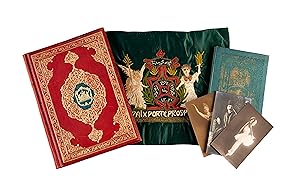
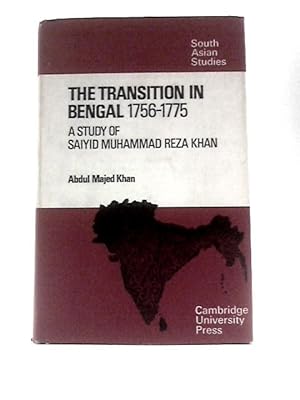
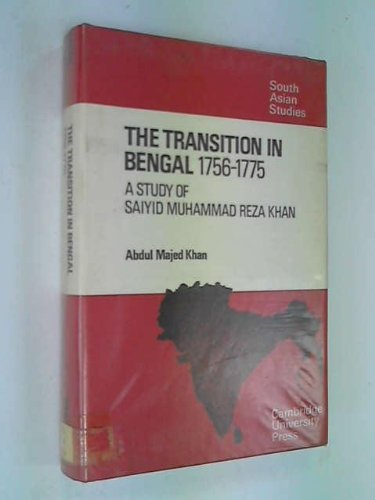
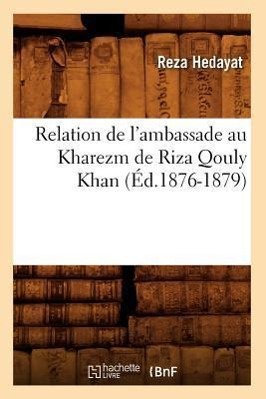

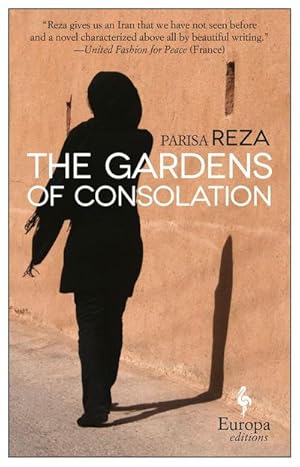

![Bild des Verkäufers für [SECRET TREATIES / ANGLO-PERSIAN AGREEMENT OF 1919] Manzûme-yi Sulh ve re'y-i Dânîsh [ve tercümesi]. [i.e. Peace agreement and views of Mirzâ Dânîsh]. Translated into Ottoman Turkish by Ferid [Kam]. zum Verkauf von Khalkedon Rare Books, IOBA](https://pictures.abebooks.com/inventory/md/md30943970220.jpg)

